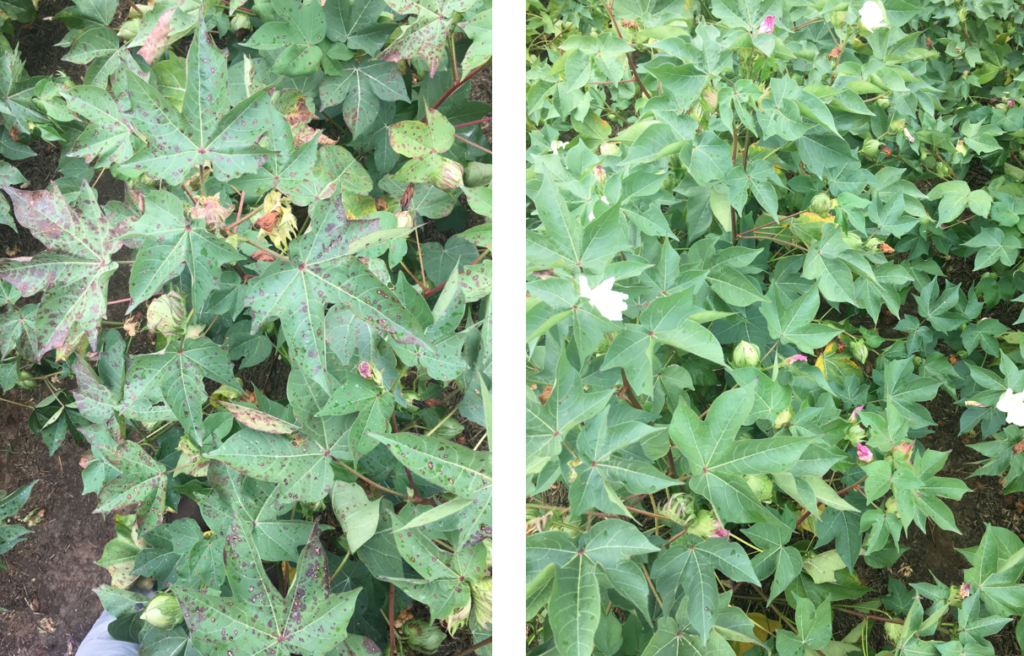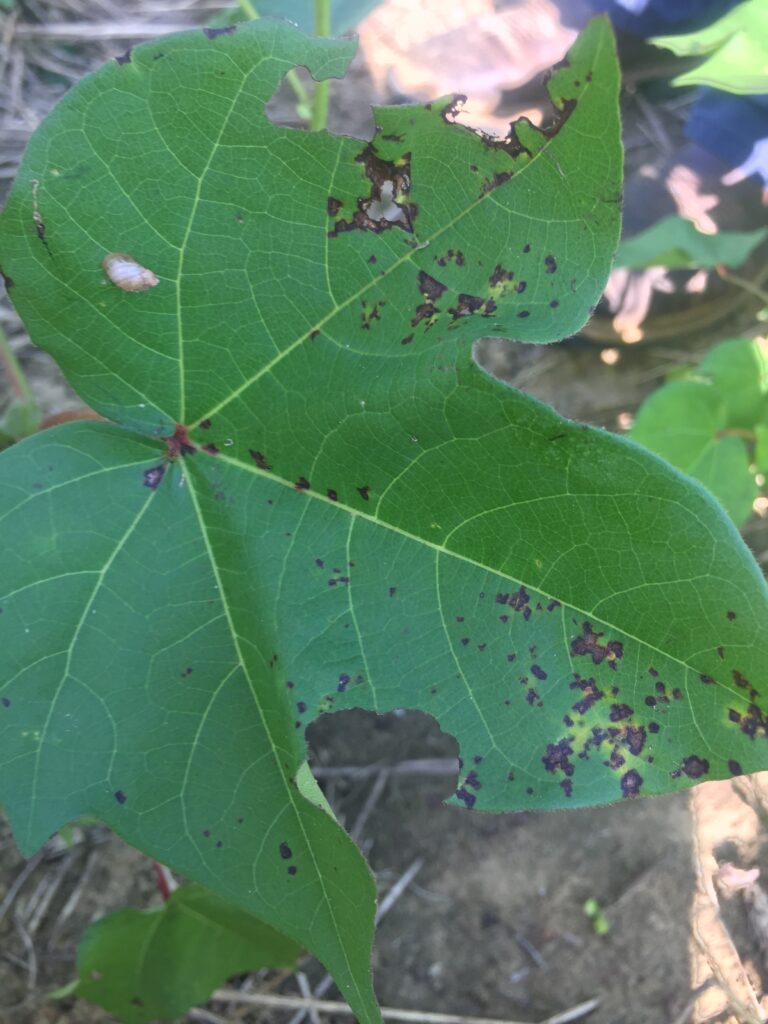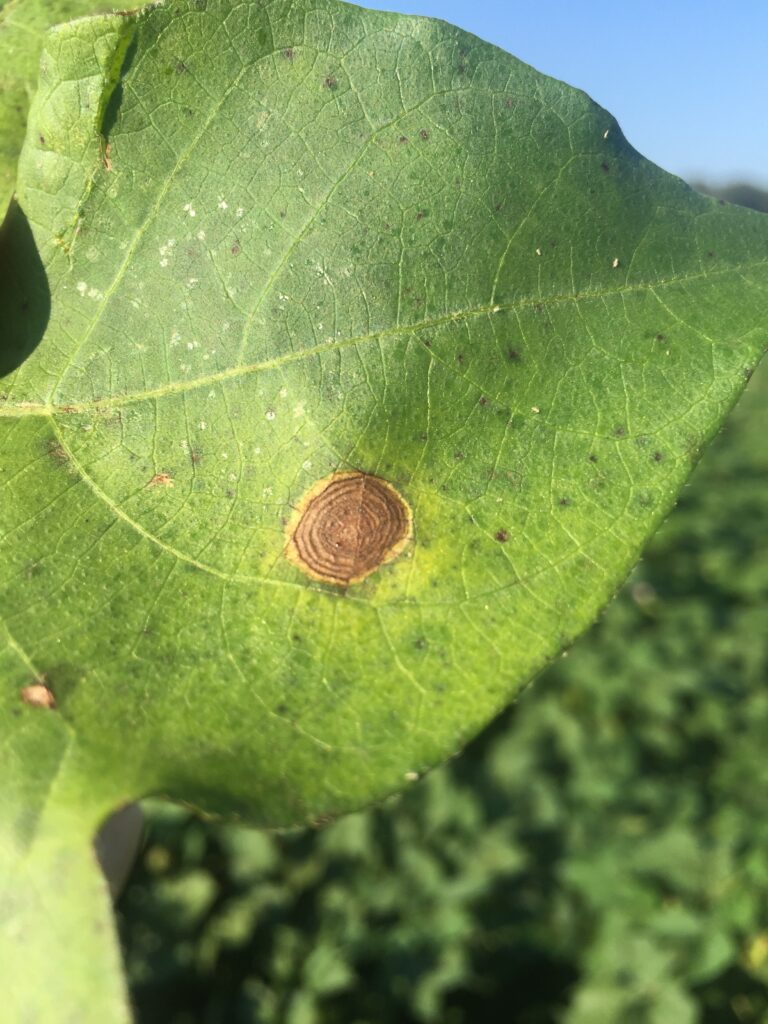
August has turned wet, and while I generally like rain through July and August, we could now tolerate a few dry, clear days. Much of our canopy has remained wet over the past week, and as you might expect, the leaf spot complex has appeared in some of our earliest planted cotton. Subsequently, foliar fungicide use in cotton has been the topic of conversation for August. Fortunately, most of our research on fungicide use in cotton is pretty straight-forward. In this blog, I share a few thoughts concerning foliar fungicide use in cotton and link to a few of Dr. Heather Kelly’s deliverables from the past few years.
We often refer to Alternaria, Cercospera, and Stemphylium as the leaf spot complex (displayed in the left image above) since their symptoms and management are very similar. This complex usually appears during boll fill and is most commonly associated with nutrient stress and is most common when other environmental stressors are also present (drought, compaction, etc.). Pathology labs can differentiate between the three, but again, there is little utility in knowing which of the three leaf spot complex diseases is present since management does not change between the three of them. Foliar fungicides may reduce incidence of this complex, but you should expect NO YIELD RESPONSE. The two images above were collected in a foliar fungicide trial I completed in 2020. The left image is the control (no fungicide applied). The right image is where a fungicide was applied (I’m only including one image, but all fungicides evaluated generated the same, clean canopy). I evaluated timings at 3rd week of bloom, 5th week of bloom, and 3rd+5th week of bloom. AVERAGE YIELD FROM FUNGICIDE TREATMENTS WAS 1,504 lb lint/acre. AVERAGE OF UNTREATED CHECKS- 1,515 lb lint/acre. Take home: don’t expect a yield response from a foliar fungicide if you are going after Alternaria/Cercpospera/Stemphylium.

Bacterial blight, pictured above, is a disease that comes and goes in West Tennessee; while we had a few bad years in 16 and 17, incidence since has been low and yield impacts negligible. I’ve received a few photographs this year which would suggest we may have some in West TN, but it looks like incidence for 23 may remain low. Bacterial blight lesions on leaves are angular and often run down the vein of a leaf. Impacted areas may initially appear water soaked, particularly if looking at the underside of the leaf, before turning necrotic. Lesions often appear in a shotgun pattern across the leaf (see above) and can move onto the boll. Management of bacterial blight is limited to selection of resistant varieties. Many of our most widely planted varieties are susceptible. If you note the disease in your field, consider planting a resistant variety next year. To quote Dr. Bob Kemerait, Field Crops Pathologist in Georgia: “. . . there is nothing we can spray to stop it.” Don’t waste time or money applying a foliar fungicide to bacterial blight!
 Target spot has also (fortunately) been inconsistent for us in recent years. This is a disease of high-yielding cotton and is mainly associated with a dense canopy. Lesions on leaves have concentric rings- that’s how the disease received the ‘target’ common name. Keep in mind that leaves usually have an effective life of roughly 60 days. If you are observing Target Spots on lower, mainstem, old leaves, I would not be concerned; I only become concerned with Target Spot when the disease begins to move up into the canopy and lesions begin to appear on subtending leaves adjacent immature bolls. If you begin to observe the disease on young leaves or subtending leaves mid-way up the canopy or higher, I would consider applying a fungicide. Moving forward, I would also encourage you to consider reducing your Nitrogen (N) rate, reducing your planting population, and considering a more aggressive plant growth regulator (PGR) regime.
Target spot has also (fortunately) been inconsistent for us in recent years. This is a disease of high-yielding cotton and is mainly associated with a dense canopy. Lesions on leaves have concentric rings- that’s how the disease received the ‘target’ common name. Keep in mind that leaves usually have an effective life of roughly 60 days. If you are observing Target Spots on lower, mainstem, old leaves, I would not be concerned; I only become concerned with Target Spot when the disease begins to move up into the canopy and lesions begin to appear on subtending leaves adjacent immature bolls. If you begin to observe the disease on young leaves or subtending leaves mid-way up the canopy or higher, I would consider applying a fungicide. Moving forward, I would also encourage you to consider reducing your Nitrogen (N) rate, reducing your planting population, and considering a more aggressive plant growth regulator (PGR) regime.
The next disease I want to mention is Verticillium Wilt. I’ve received a few pictures that appear to be vert this year. This is not a disease that we typically see across a large number of acres in West Tennessee, but it is relatively common in Middle Tennessee and North Alabama. Vert often first appears mid-way up the canopy as a chlorotic panels of leaves which progress to necrotic. If you split the main stem, you will often see brown staining. Susceptibility to Vert varies by variety. If you see Vert within your field at a concerning level, do not apply a fungicide but instead consider selecting a variety next year that might tolerate the disease better.
Finally, I want to mention boll rot. If our current weather conditions hold, I suspect we will see boll rot as we move later into the boll fill period. Boll rot can be caused by a very large number of species and research evaluating fungicides suggest they typically have no impact on boll rot. Management decisions which increase the airflow into the canopy and properly managing insect pests are the two best approaches to reducing boll rot.
To learn more about these diseases and how to identify what might be present within the field, please review Dr. Kelly et al.’s manual titled, ‘Diagnosis and Management of Foliar Diseases of Cotton in the United States’ and mobile friendly field guide at guide.utcrops.com/cotton.

